Ballarat Greyhound Racing Club
LCA: City of Ballarat
President: Craig Fletcher
Manager: Jodie Faralla
Tel:(03) 5335 7201
Fax: (03) 5335 7104
Email: ballarat@grv.org.au
Website: ballarat.grv.org.au
Address: Corner of Rubicon & Sutton Streets, Ballarat
Postal: PO Box 175R, Reden, 3350
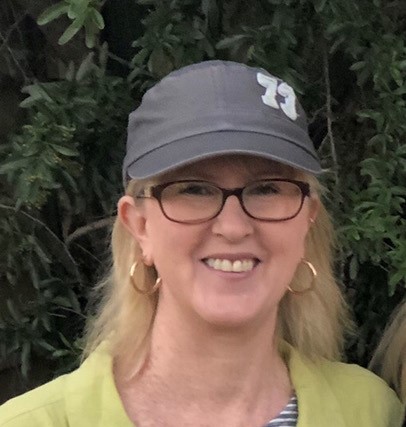
Club Manager - Jodie Faralla
When Jodie Faralla was recently appointed manager of the Ballarat Greyhound Racing Club she felt like she was “coming home.”
For Jodie, the appointment in August this year, brought back a flood of childhood memories.
Some of her earliest childhood “fun times” were spent at the Ballarat track where her father, Ron Hood, was Secretary/Manager from 1978 to 1990.
Jodie’s entire working life has revolved around racing. After leaving school and Ballarat she moved to Melbourne and took on a position at Tabcorp where she had numerous roles including Race-day Operations Manager, Business Analyst and Marketing Manager - Racing.
For the past 15 years she has been at the coalface of the industry as a small business operator running a number of TAB betting outlets, most recently at Campbellfield and Belmont in Geelong.
All of that industry experience holds her in good stead for her current position where her first objective is engagement and participation.
“My vision for the club is ‘Ballarat greyhounds where people love to work, race and participate’,” Jodie said.
“There has been a level of disconnect between the club and some of the traditional supporters. One of the great things about greyhound racing is that people, including several members of my family, have dedicated their whole lives to it – they are invested in the place and now second and third generations of families are coming along.
“I see it as my role to bring my team of staff, the Committee and the club members closer together and for everyone to be working towards what is really important, the on-going success of the club.” Jodie wants to invite the people of Ballarat to get involved, enjoy the racing and develop a whole new community of greyhound supporters
More importantly, Jodie’s most immediate objective is improvements to infrastructure. With the club’s “fantastic” facilities for patrons already in place, it’s time to upgrade the original kennelling facilities and carparking to 21st century industry standards.
HISTORY OF THE BALLARAT GREYHOUND RACING CLUB
In the summer 1935 Messrs McRae and Bill Jackson introduced greyhound racing behind the pacemaker at Broadway Park in Creswick Road on the northern outskirts of Ballarat. The land was originally a dairy farm owned by Charlie Lockett who became the caretaker and supplier of the pacemakers. His grandson, AFL legend Tony, continued the family tradition, owning a string of successful greyhounds.
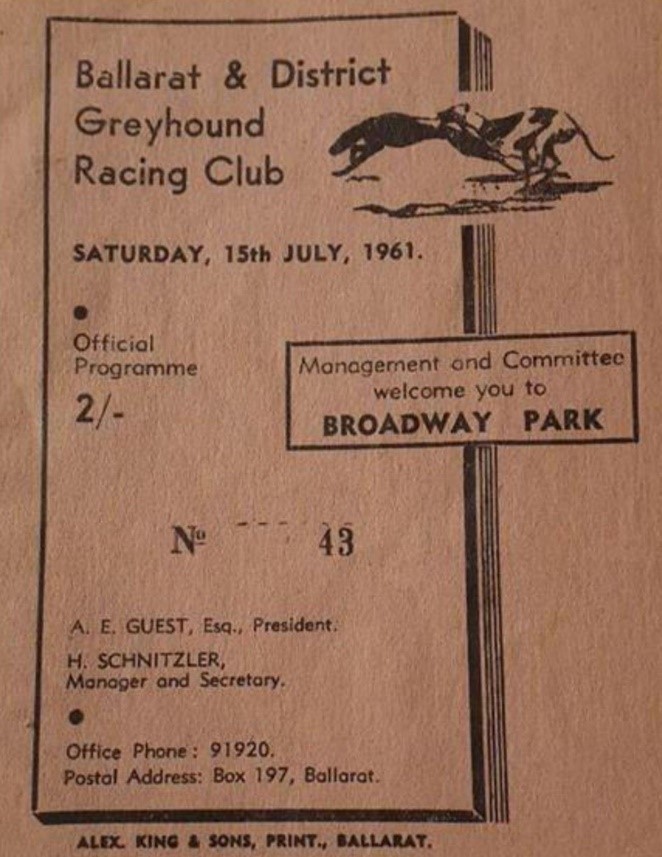 Racing was held on Thursday nights (a shrewd link to pay day). Many of the greyhounds were entered by employees of two nearby companies, engineering firm M. B. Johns and the Railway workshops, both within two blocks of the track. With large numbers of greyhounds kennelled within the near vicinity of the track, it was to prove to be a very popular location.
Racing was held on Thursday nights (a shrewd link to pay day). Many of the greyhounds were entered by employees of two nearby companies, engineering firm M. B. Johns and the Railway workshops, both within two blocks of the track. With large numbers of greyhounds kennelled within the near vicinity of the track, it was to prove to be a very popular location.
Many greyhounds that raced in those early days were bred in South Australia and doubled up in both track races and the Plumpton. Plumpton racing was held on a Sunday where the greyhounds would chase a live hare for as long as 15 minutes. In addition, many greyhounds backed up as hurdlers jumping over hurdles made from fire hose and later from brooms standing up on end. The greyhounds were nothing if not versatile. Times were tough in the 1930s, Ballarat Greyhound Racing Club (BGRC) Life member Bill Middlin remembers £10 [$660] being a big prize at the greyhounds and as a 14 year old in the late 1930s, he was paid 6 shillings ($20) a week for walking greyhounds at night. This made the price of entry of 1/6 ($51) a big sum in the Depression. However, if you had a greyhound, entry was free. Hence punters would stand around the gate waiting to offer handling assistance to owners with more than one greyhound to get free entry to the track.
Local Ballarat resident Mark Simpson recalls his father Charlie Simpson was an owner trainer for 65 years in Ballarat also his father James Simpson from up in Walker St. Between them they raced foxes, whippets, and greyhounds. He has a trophy that has been handed down from his Grandfather. The engraving reads Presented to East Ballarat Coursing Club by Mr J Stubbs 1936. It is the oldest known trophy in Ballarat greyhound history.
Punters at Ballarat were no different from other punters across the State. A big win at the greyhounds could be the difference between the family eating or going hungry that week. Families, both human and canine needed to stick together. Ed Ure was Ballarat Club President from 1998 to 2006 when the track moved to Morshead Park. He remembers one particular trainer with a litter of six greyhounds. Somehow, the fastest greyhound in the litter won its own maiden and was then rung in to win five more maidens for its brothers and sisters.
 In 1955, with the advent of mechanical hare racing and the abolition of the proprietary clubs, £3500 ($96,000) was needed to purchase the title of the land from the proprietary club. Bob Coleman made a major contribution by pouring £600 ($16,500) into the debenture issue.
In 1955, with the advent of mechanical hare racing and the abolition of the proprietary clubs, £3500 ($96,000) was needed to purchase the title of the land from the proprietary club. Bob Coleman made a major contribution by pouring £600 ($16,500) into the debenture issue.
However, conditions at Broadway Park were rustic at best with big braziers burning around the track to keep people warm on very cold nights. The set of old platform scales that were used to weigh the greyhounds before a race provided a little space that enabled trainers to put their foot under the scales and manipulate the "correct" weight for a greyhound. This serendipitous opportunity was very important if the greyhound had inadvertently eaten too much in the days before the race and was in danger of running more slowly than trial times had suggested.
Bookmaker and local stalwart Tommy Murphy remembers that during the 1960s and before TAB betting, greyhound racing was at a very low ebb in Ballarat. Originally, the club had raced on a Thursday night with Sandown meetings being held on a Saturday. A switch in dates occurred to attract crowds and with a promise of TAB meetings, racing at Ballarat was moved to Saturday afternoon. However, once Sandown started, it became difficult to get greyhounds to race in Ballarat and fields were so small that the bookies also had to bet on the gallops.
It became hard for the bookies to make a living with race meetings often only having 25 greyhounds and five races. In addition, the quality of the greyhounds declined and with many of the greyhounds not chasing well there was a corresponding decline in interest in the sport. This situation was not helped by the fact that in the days before inoculations for distemper and hepatitis and treatments for parasites such as tapeworm (all of which caused very high loss rates), it was a very difficult time to maintain greyhounds in good racing condition.
In addition, the Broadway Park track was small with very tight corners and falls were frequent. It was not uncommon for greyhounds that fell at the first turn to jump the rail and try to cut across the middle of the track in an attempt to re-join the race. This was hindered by a dam in the middle of the track that became partly frozen during the depths of many a Ballarat winter, very few greyhounds that plunged into the lake were keen to repeat the shortcut.
Racing in Ballarat reached its lowest point when Melbourne GOTBA member George Schofield received a late-night phone call from the Ballarat Club secretary saying that attendances were down so far that the club was broke and would have to close. The GOTBA chose to assist by way of a rescue operation.
A series of meeting involving George, Jack McKenna, Henry Harrison, Roy Duncan and Les Foran led to the Greyhound Control Board agreeing to have GOTBA take over the club. The condition was that the GOTBA would take the over the committee and the weekby-week running of the club until it was back on its feet financially. It was a long process with George and GOTBA members, Roy Duncan and Les Foran, driving to Ballarat every Saturday to run the meetings that now included footraces between players from the local football competition. This move brought many football supporters to race meetings. The clubs position improved to the point that GOTBA was able to hand the running of the club back to the local committee with the GOTBA being represented by the ongoing participation of George Schofield.
Eventually, the Club Committee welcomed the opportunity to move to a new location at Morshead Park beside the Ballarat Trotting Club complex.
 Originally the Miners Common, the Miners Race Course had been used by the Ballarat Miners Turf Club. The park was named after Ballarat born Lieutenant General Leslie James Morshead, KCB, KBE, CMG, DSO who served at Gallipoli and Passchendaele in WW1 and Tobruk, El Alamein and New Guinea in WW2. Forty years after the pacemaker and then tin hare racing took place at Broadway Park, a new track opened for racing on the 23rd December 1978. Karingal Silver (trained by Patricia Helps) had the privilege of winning the last race at Broadway Park on Wednesday 8th November 1978. History shows that the first race on the new track was won by Eddy Tornado which won from Box one and was trained by W.R. Dalton. Tivoli Salute (trained by Cyril Matthews) had the honour of winning on both the last night at Broadway Park and then on the opening night at Morshead Park. On that opening night, a match race between two metropolitan class greyhounds saw Darville’s Flyer beat Tangaloa by 7.5 lengths in 25.69. Later in the program, Tivoli Salute recorded 25.48 in the Irish Cup and then proceeded to break his record again at the following two meetings. It was quite a promotion to have Melbourne Cup winner Tangaloa and Sandown track record holder Darville’s Flyer do battle. There was also a parade of the best Sire’s standing at stud at the time. The "official" opening of Morshead Park was held later on the 6th of January 1979.
Originally the Miners Common, the Miners Race Course had been used by the Ballarat Miners Turf Club. The park was named after Ballarat born Lieutenant General Leslie James Morshead, KCB, KBE, CMG, DSO who served at Gallipoli and Passchendaele in WW1 and Tobruk, El Alamein and New Guinea in WW2. Forty years after the pacemaker and then tin hare racing took place at Broadway Park, a new track opened for racing on the 23rd December 1978. Karingal Silver (trained by Patricia Helps) had the privilege of winning the last race at Broadway Park on Wednesday 8th November 1978. History shows that the first race on the new track was won by Eddy Tornado which won from Box one and was trained by W.R. Dalton. Tivoli Salute (trained by Cyril Matthews) had the honour of winning on both the last night at Broadway Park and then on the opening night at Morshead Park. On that opening night, a match race between two metropolitan class greyhounds saw Darville’s Flyer beat Tangaloa by 7.5 lengths in 25.69. Later in the program, Tivoli Salute recorded 25.48 in the Irish Cup and then proceeded to break his record again at the following two meetings. It was quite a promotion to have Melbourne Cup winner Tangaloa and Sandown track record holder Darville’s Flyer do battle. There was also a parade of the best Sire’s standing at stud at the time. The "official" opening of Morshead Park was held later on the 6th of January 1979.
A picture containing clothing, curtain, shirt Description automatically generated"
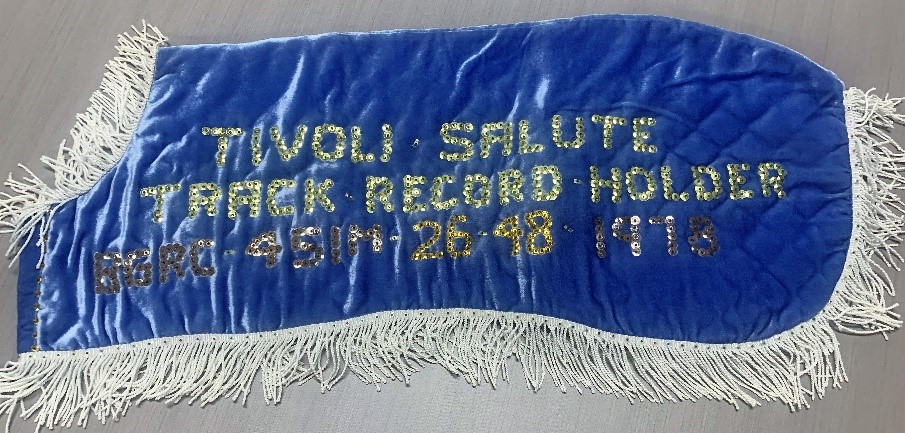
The original race distances at Morshead Park were 450 metres and 735 metres. With a drop in the number of greyhounds racing over the 735 metres, 550 metre boxes were introduced in 1985. While the opening night had been a sell-out, the transition to night racing on the now expansive new track was very difficult for many greyhounds. However, as time went on, the new track gained a reputation as being good, fair and open with only one bend, in contrast to the City tracks which both had two bends, meaning that strong greyhounds tended to win at Ballarat. The new track and facilities at Morshead Park were the result of many hours of volunteer work particularly by Committee and Club Members. This culture of volunteerism has been an important corner stone of the Club from its early beginnings until the present. Since the opening of Morshead Park in 1978, the Club has continuously worked towards upgrading facilities. Major changes have seen the introduction of a fully computerised tote and on-course video coverage which began in 1982.
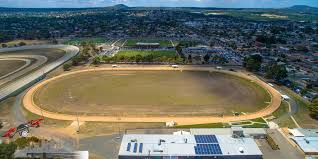
In 1991, a new timing system complete with split time at the 310m mark went into operation. An upgrade of lighting at all tracks in 1992, by the then Development Board, saw Morshead Park in a much brighter light. In the late 1990s, the kennel block underwent a major redevelopment, with further improvements placing all kennels on ground level occurring during 2003. The announcement in July 1994 that as from August 1994. Ballarat race meetings would be televised by SKY Channel on Wednesday evening was met with great delight by all connected with the Club. This reward for already excellent off-course figures was seen to be a boon by the Club. With a trend back towards providing more opportunities for greyhounds to race over longer distances, the club later introduced 650 metre handicap boxes.
Since those years we have seen many improvements that ensure maximum comfort for patrons. The glassing in of the grandstand and betting ring in 1996 was followed in 2007 with further improvements including carpeting and a floor to ceiling viewing area. Further, outdoor summer facilities were provided, and additional improvements aimed at expanding function facilities in the grandstand occurred in 2009.
The club has run a number of Picnic Meetings/GOTBA Meetings over the years where donations have been made to charities. The culture of the Ballarat Greyhound Racing Club has always cantered on the excellence of working committees, which enabled the club to maintain decent prize money during years when distribution was not always generous. Without the hard work of Committee members, too numerous to mention, the Morshead Park track would not be as highly regarded as it is today. Always known as a speed track were most dogs have a fair chance to show their best.
The Club provides excellent public facilities where patrons can enjoy undercover comfort from the grandstand. Bar facilities, catering and off street car parking are also available. Track facilities also include Tabcorp betting facilities, video replays of all races with all races being broadcast on and off course. The club holds over 100 race meetings every year, races each Monday, day meeting and Wednesday night with some additional meetings conducted throughout the year.
The club has a 220-guest seating capacity with function rooms available for a wide range of events. Its feature event is the most sought-after Ballarat Cup held in December, and it is one of only three clubs in Victoria that offers qualifying trails. The club employs 4 people full time and up to 7 casual workers on race day while greyhound racing contributes over $16 million annually to the region in wages and buying goods and services locally. The Ballarat Greyhound Racing Club enjoys an ongoing partnership with the City of Ballarat, a range of local business sponsors, families from the districts and many community-based organisations. The club offers a range of community groups access to its facilities for fundraisers and charity days. The Great Chase an annual event raises money for community groups that work with the aged and disabled and gives their clients a great day out at the races. Since 2003 the Ballarat Great Chase Community Days have donated around $20,000 to local community groups. They are also involved in the Greyhound Adoption Program (GAP) hosting adoption days and regular assessments for retiring racers so they can enter GAP.
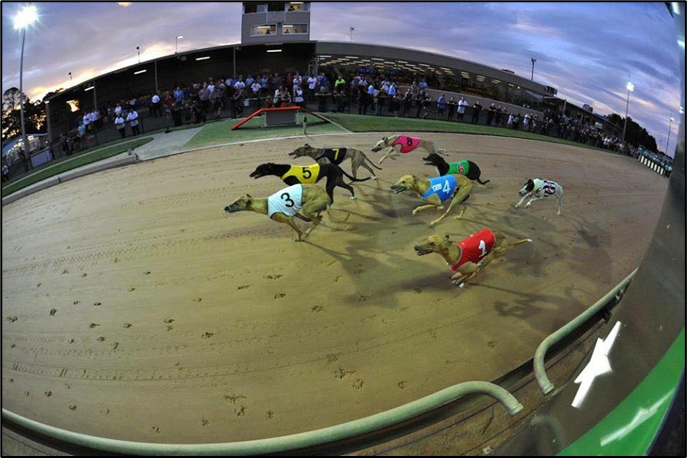
PRESIDENTS BROADWAY PARK
- Joe Simpson
- Allan Guest
- Les Foran
- Tom Evans
PRESIDENTS MORSHEAD PARK
- Alf Howell 1979-87
- Larry Downs 1988-94
- Ed Ure 1995-2006
- Ken Bennett 2007-09
- Alf King 2010
- Wayne Wrout 2011
- Peter Desmond 2011-12
- Alf King 2012-19
- Tim Bunning 2019-2020
- Paul Armstrong 2020
Fun Facts
On April 12th 1975 Ballarat hosted an unusual event the Victorian Marathon Championship over 841 metres. The final was won by Summer Judy a black bitch by Holding from Summer Gown. She beat Tarragon Miss and Colonial View. The margins were three and half by a half in the time of 53.45. There were always a few marathons run up until the early 80’s Sandown featured one each year run from 515 boxes. The most famous marathon winner in history would be the mighty Zoom Top. So versatile was the superstar in July 1968 she raced against the best sprinters in New South Wales in the final of the Winter Stake (457 metres) and finishing second. Two days later at Beenleigh she won the Queensland Distance Championship by eight lengths in track record time of 47 and 4 tenths over 795 metres. She came back to Beenleigh in 1969 and won the final again breaking her own record running 47.2 at her 101st start.
The best greyhound to come from the Ballarat area would undoubtedly be Bombastic Shiraz bred and raced by the Cairns family David, Kaye and trainer Darren the champ was whelped at Lal Lal 20 kilometres from Ballarat. Amazingly in his 35 start career he never raced on any other tracks except Sandown, the Meadows and two starts at Wentworth Park. In a short but outstanding race career he won 18 times and was placed on 11 occasions for $355,915 in prizemoney. In a purple patch in late 2003 he won the Shoot-Out, Melbourne Cup and Top Gun. Retiring to stud after the Top Gun win, he proved an instant success producing Victorian and AGRA Greyhound of the Year Flashing Floods from his first litter. Standing for leading Stud masters firstly Bob Douglas and then Geoff Collins he sired 3968 pups. In a long list of high-class performers and in no order the best would be Miata, Fabregas, Cindeen Shelby, Velocette, Spud Regis, Regal Thyme, Bit Chilli, Metz Magic and Spring Gun. Bombastic Shiraz won the 2003 Victorian and AGRA Greyhound of the Year, the AGRA Stud Dog of the Year 2008, 2009, 2012 and 2013. He was inducted into the Victorian Hall of Fame in 2013.
